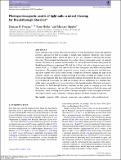Files in this item
Photogravimagnetic assists of light sails : a mixed blessing for Breakthrough Starshot?
Item metadata
| dc.contributor.author | Forgan, Duncan H. | |
| dc.contributor.author | Heller, René | |
| dc.contributor.author | Hippke, Michael | |
| dc.date.accessioned | 2018-01-18T15:30:11Z | |
| dc.date.available | 2018-01-18T15:30:11Z | |
| dc.date.issued | 2018-03 | |
| dc.identifier | 252090769 | |
| dc.identifier | ba1526b0-d1df-4045-bd08-16e94b795e5f | |
| dc.identifier | 85040254963 | |
| dc.identifier | 000424347900026 | |
| dc.identifier.citation | Forgan , D H , Heller , R & Hippke , M 2018 , ' Photogravimagnetic assists of light sails : a mixed blessing for Breakthrough Starshot? ' , Monthly Notices of the Royal Astronomical Society , vol. 474 , no. 3 , pp. 3212-3220 . https://doi.org/10.1093/mnras/stx2834 | en |
| dc.identifier.issn | 0035-8711 | |
| dc.identifier.uri | https://hdl.handle.net/10023/12510 | |
| dc.description | DF gratefully acknowledges support from the ECOGAL project, grant agreement 291227, funded by the European Research Council under ERC-2011-ADG. This work was supported in part by the German space agency (Deutsches Zentrum für Luft- und Raumfahrt) under PLATO Data Center grant 50OO1501. | en |
| dc.description.abstract | Upon entering a star system, light sails are subject to both gravitational forces and radiation pressure, and can use both in concert to modify their trajectory. Moreover, stars possess significant magnetic fields, and if the sail is in any way charged, it will feel the Lorentz force also. We investigate the dynamics of so-called 'photogravimagnetic assists' of sailcraft around α Centauri A, a potential first destination en route to Proxima Centauri (the goal of the Breakthrough Starshot programme). We find that a 10-m2 sail with a charge-to-mass ratio of around 10 μC g-1 or higher will need to take account of magnetic field effects during orbital manoeuvres. The magnetic field can provide an extra source of deceleration and deflection, and allow capture on to closer orbits around a target star. However, flipping the sign of the sailcraft's charge can radically change resulting trajectories, resulting in complex loop-de-loops around magnetic field lines and essentially random ejection from the star system. Even on well-behaved trajectories, the field can generate off-axis deflections at α Centauri that, while minor, can result in very poor targeting of the final destination (Proxima) post-assist. Fortunately for Breakthrough Starshot, nanosails are less prone to charging en route than their heavier counterparts, but can still accrue relatively high charge at both the origin and destination, when travelling at low speeds. Photogravimagnetic assists are highly non-trivial, and require careful course correction to mitigate against unwanted changes in trajectory. | |
| dc.format.extent | 9 | |
| dc.format.extent | 1833575 | |
| dc.language.iso | eng | |
| dc.relation.ispartof | Monthly Notices of the Royal Astronomical Society | en |
| dc.subject | Magnetic fields | en |
| dc.subject | Methods: numerical | en |
| dc.subject | Solar neighbourhood | en |
| dc.subject | Space vehicles | en |
| dc.subject | QB Astronomy | en |
| dc.subject | Astronomy and Astrophysics | en |
| dc.subject | Space and Planetary Science | en |
| dc.subject | NDAS | en |
| dc.subject.lcc | QB | en |
| dc.title | Photogravimagnetic assists of light sails : a mixed blessing for Breakthrough Starshot? | en |
| dc.type | Journal article | en |
| dc.contributor.sponsor | European Research Council | en |
| dc.contributor.institution | University of St Andrews. St Andrews Centre for Exoplanet Science | en |
| dc.contributor.institution | University of St Andrews. School of Physics and Astronomy | en |
| dc.identifier.doi | 10.1093/mnras/stx2834 | |
| dc.description.status | Peer reviewed | en |
| dc.identifier.grantnumber | en |
This item appears in the following Collection(s)
Items in the St Andrews Research Repository are protected by copyright, with all rights reserved, unless otherwise indicated.

